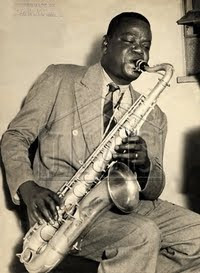The Sound Of The Violão Tenor
 When I started listening to Brazilian recordings, I was fascinated by the sound of the violão tenor right from the start. One of the artists playing this instrument, who had my attention, was Garoto (Anibal Augusto Sardinha), of course. According to some sources it was Garoto, who introduced the violão tenor in Brazil in 1932 - he had imported a copy from the USA and was to use it intensely in performance and recordings during the remain of his career. I 'recognised' the sound of the violão tenor from recordings with Carmen Miranda featuring Garoto, it reminded me of the sound of Oscar Alemán - the Argentine swing guitar player, who had his career at the same time as Garoto. In fact, recognition of the sound of the two guitarists as similar was not a coincidence, the instrument played by both musicians had a built-in resonator device, that made the sound of the instrument recognizable instantly. The resonator system of the guitar was developed to help solving amplification of the sound before electricity was used for amplification. It was developed in the USA by the National Guitar company, specializing in metal shaped instruments with a built-in resonator, that functioned like a kind of membran speaker, amplifying the sound of the strings when played. The National Guitar models were often used by steel bar guitar players in Hawaiian style music, popular at the time, but also blues and jazz guitar players were attracted by the sound and volume effect of the instrument. In Brazil, local luthiers like the workshop of Del Vecchio developed a model of the resonator guitar different from the US issue, as the body of the guitar remained a box of wood with visible built-in resonators on the surface instead of a soundhole (- see picture above). However, players of the Del Vecchio model - both the 6 string violão and the 4 string violão tenor - often had problems staying tuned during performance due to the construction of the instrument. Anyway, when in tune, the sound of the instrument is recognizable instantly, and below I insert some video examples to give you an impression of this fascinating hybrid.
When I started listening to Brazilian recordings, I was fascinated by the sound of the violão tenor right from the start. One of the artists playing this instrument, who had my attention, was Garoto (Anibal Augusto Sardinha), of course. According to some sources it was Garoto, who introduced the violão tenor in Brazil in 1932 - he had imported a copy from the USA and was to use it intensely in performance and recordings during the remain of his career. I 'recognised' the sound of the violão tenor from recordings with Carmen Miranda featuring Garoto, it reminded me of the sound of Oscar Alemán - the Argentine swing guitar player, who had his career at the same time as Garoto. In fact, recognition of the sound of the two guitarists as similar was not a coincidence, the instrument played by both musicians had a built-in resonator device, that made the sound of the instrument recognizable instantly. The resonator system of the guitar was developed to help solving amplification of the sound before electricity was used for amplification. It was developed in the USA by the National Guitar company, specializing in metal shaped instruments with a built-in resonator, that functioned like a kind of membran speaker, amplifying the sound of the strings when played. The National Guitar models were often used by steel bar guitar players in Hawaiian style music, popular at the time, but also blues and jazz guitar players were attracted by the sound and volume effect of the instrument. In Brazil, local luthiers like the workshop of Del Vecchio developed a model of the resonator guitar different from the US issue, as the body of the guitar remained a box of wood with visible built-in resonators on the surface instead of a soundhole (- see picture above). However, players of the Del Vecchio model - both the 6 string violão and the 4 string violão tenor - often had problems staying tuned during performance due to the construction of the instrument. Anyway, when in tune, the sound of the instrument is recognizable instantly, and below I insert some video examples to give you an impression of this fascinating hybrid.
Garoto probably was the first to use the Del Vecchio violão tenor in performance and recordings. Later other violanista followed, i.e. Claudionor Cruz, Zé Menezes and Alvaro Brochado. In contemporary Brazil the violão tenor is not so common, but in previous blog postings I have pointed you to contemporary players of the instrument, like Pedro Amorim, Henrique Cazes, Marco De Pinna and - just recently - Renato Anesi. During the last week I just discovered that another well known violanista of the contemporary scene in Brazil, Alessandro Penezzi, in fact played the Del Vecchio violão tenor model early in his career. Below I insert some uploaded video performances, recorded 1990 with the choro ensemble Conjunto Som Brasileiro at a live concert.
The first tune played by Conjunto Som Brasileiro featuring Alessandro Penezzi on violão tenor is Pixinguinha's "Vou Vivendo"
The next tune from the same live performance is a rendition of Luiz Americano's "Numa Seresta"
The last video this time is a rendition of Jacob do Bandolim's "A Ginga do Mané" - enjoy this masterpiece, one of the few choros performed by Jacob on the violão tenor, here played convincingly by Alessandro Penezzi with Conjunto Som Brasileiro
Jo




.jpg)






